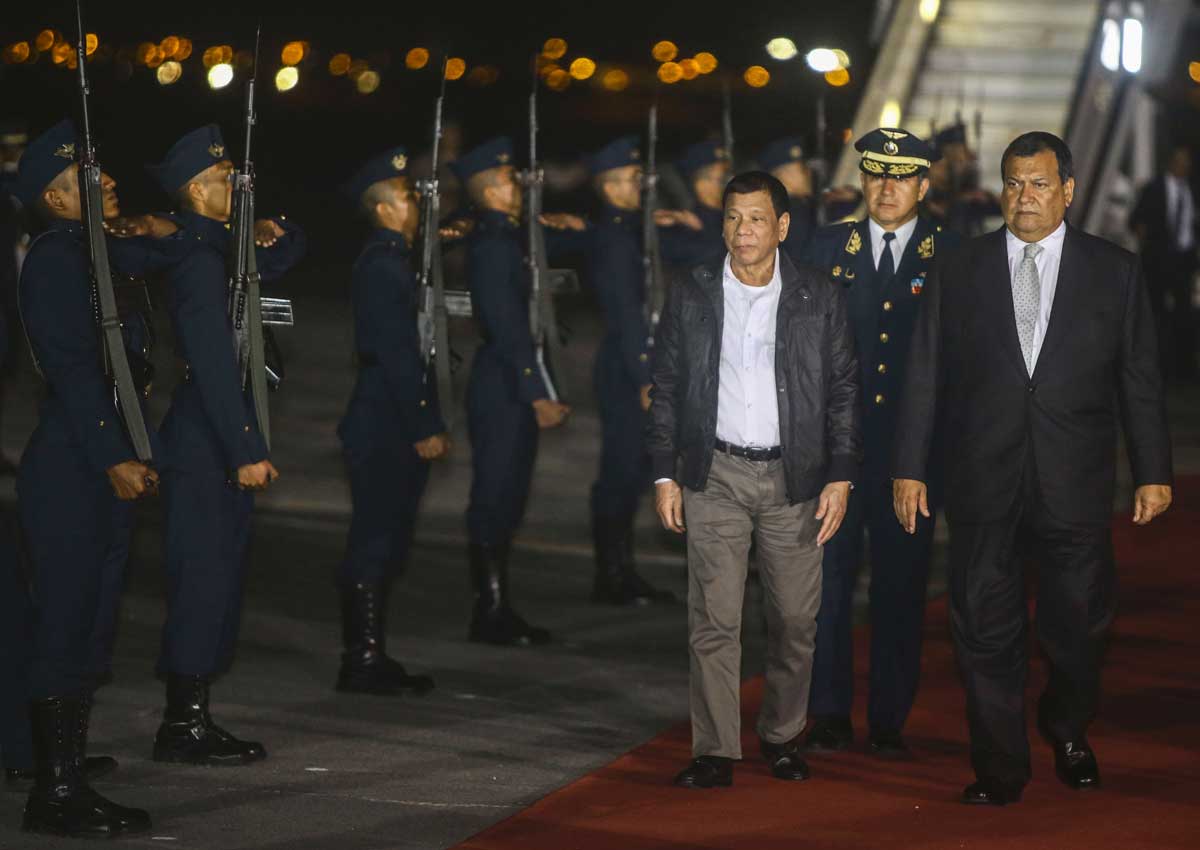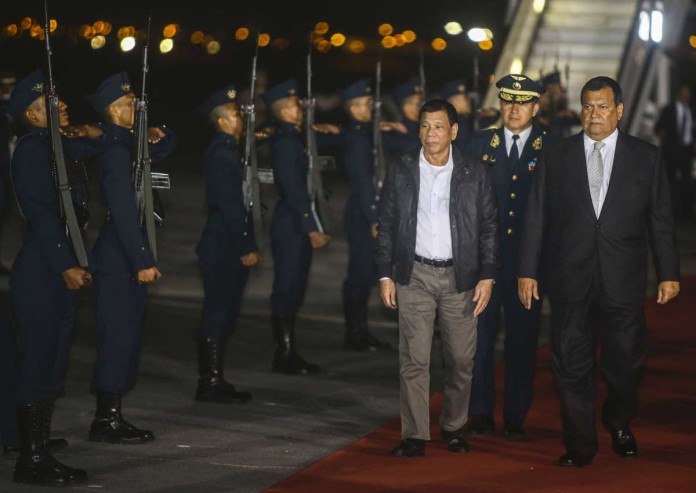At the centuries-old Chinese enclave of Binondo in the heart of Manila, China is a distant, bygone presence.
Carved out of the Philippine capital by the Spaniards in 1594, the 66ha district is the oldest and largest Chinese quarter in the world. It was where millions of Chinese fleeing the communists in the 1930s till the 1970s docked.
Some settled there, opening small businesses that relied on their connections to the mainland. But most spread out across the Philippines.
Today, with a population of about 15,000, Binondo is just another attraction that Filipinos flock to during Chinese New Year, a superficial representation of Chinese influence in the country.
It is an influence most keenly felt in commerce, and less so in politics, as politicians tend to downplay their Chinese lineage.
President Rodrigo Duterte’s recent efforts to shift the Philippines away from the US and towards China – an old adversary, not least because of the two countries’ row over the South China Sea – is unlikely to change that.
For one thing, the timeframe is too short, with President Duterte limited to just one six-year term in office.
For another, the scale of economic exchange – with US$24 billion (S$34 billion) in investments pledges, US$680 million in annual trade, and the promise of a million Chinese tourists annually – is too small. Even the 30 million Chinese-Filipinos, roughly a third of the country’s population, are unlikely to be moved by Mr Duterte’s shift.
That’s because many of them, while retaining their Chinese surnames, have, like most Filipinos, grown up on a steady diet of everything American. They do not share Mr Duterte’s love for China.
“The common sentiment among my peers is: why is he so tactless, so insensitive, in his speeches, especially against the US?” said Mr Edward Go, a marketing executive whose grandfather briefly lived in Binondo after arriving arriving from China’s Fujian province after World War II.
“We’re not against China or are pro-US, but we believe what makes sound business sense is that you don’t limit yourself to China. We need to look at other countries too,” added Mr Go, 32.
Younger Chinese-Filipinos, noted Professor Henry Chan, an adjunct research fellow at the National University of Singapore’s East Asia Institute, are “very localised and Philippine-centric. They are not keen on international issues”.
GENERATION GAP
It is the older ones, driven by nostalgia and the promise of big money, who are more excited.
Mr Wilson Lee-Flores, an ethnic Chinese columnist with deep connections to the most affluent Chinese families in the Philippines, said Chinese-Filipino tycoons like Mr Henry Sy see in the new rapprochement a rare chance to wet their beaks at a pool that other billionaires in the region have already grown fat from.
“We have been the odd man out. We’ve been so fixated with politics that we have been out of the loop,” said Mr Flores. “They see the pivot as purely business because they are not politicians,” he said of the richer, older Chinese in the Philippines.
Mr Sy’s SM Group retail conglomerate has six shopping malls in China. But the investments pale in comparison to those of Malaysian billionaire Robert Kuok, which include those in the Shangri-La hotels, the China World Trade Centre as well as cooking oil brands that have gained a 50 per cent share of the market.
“Everyone in South-east Asia is all over China, except us,” said Mr Flores. “It’s about time we become a normal Asian country like Thailand, Indonesia, Malaysia,” he added.
Business opportunities aside, older Chinese-Filipinos – many of whom came to the Philippines with nothing but the shirt on their back – also genuinely feel China can help the Philippines on infrastructure development, said Prof Chan.
Mr Sy didn’t even have slippers when he arrived in Manila from Fujian. Through sheer tenacity, cunning and an unbending determination never to be poor again, he turned his tiny shoes and slippers store in Binondo into a US$14 billion conglomerate.
Of the 30 million-strong ethnic Chinese community, about two million are “pure” Chinese, born in China, like Mr Sy, or born in the Philippines to ethnic Chinese parents.
They are the ones with the deepest emotional connections to the mainland, and who have the most fervent hopes riding on Mr Duterte’s “pivot” to China. They are also among the nation’s wealthiest, running companies that account for 60 per cent of the economy.
But their wealth and their tendency to keep a low profile also made them a target for criminals. From 1994 to 1996, about 650 Chinese were kidnapped; 31 were killed and about US$11 million paid in ransom.
The kidnapping scourge ebbed in later years, as criminals, many of them with ties to the police, switched to the narcotics trade.
But with Mr Duterte’s controversial anti-crime drive picking off thousands of drug dealers and addicts, kidnappers are again preying on Binondo’s wealthy Chinese traders.
Ms Teresita Ang-See, founder of the anti-crime Movement for the Restoration of Peace and Order, said six have already been abducted since March this year.
Despite that, the ethnic Chinese community remains firmly Filipino.
They do not see themselves as a motley group of outsiders manning an outpost for China, but as a unique ethnic community that is a blend of where they came from and where they are now, said Ms Ang-See.
That is why they insist on being called “tsinoys”, a portmanteau of colloquial references to Chinese and Filipino, to underscore their Philippine heritage, rather than the derogatory “intsik”, a slur that came out of a Hokkien reference to “uncle”.
Meanwhile, 28 million of the ethnic Chinese population are more accurately described as of mixed heritage – mainly Chinese but also of Filipino, American, Spanish and other European ancestry – who have been so thoroughly assimilated that they are Chinese only in name. They are Catholic, celebrate the New Year on Jan 1, do not observe Chinese festivals like the one for the Hungry Ghost month, and cannot speak Hokkien or Mandarin.
From this crop have come political giants such as Mr Duterte, whose grandmother came from Fujian, democracy icon Corazon Aquino, national hero Jose Rizal and Manila’s former archbishop and kingmaker Jaime Cardinal Sin.
GAME-CHANGER, IF NOT FOR LONG
Then there are the rest of the Filipinos. Half the total population of more than 100 million still distrust China, and nine in 10 Filipinos love the US more than most Americans do, according to surveys in 2014 and this year by pollsters Pew Research and Social Weather Stations, respectively.
Still, Mr Duterte calculates he has everything to win by wooing Beijing and little to lose by giving Washington the cold shoulder.
Growth in the Philippines is underpinned by consumer spending, which is in turn fuelled by billions of dollars worth of remittances from more than 10 million Filipinos abroad, including 3.4 million in the US alone, as well as a burgeoning call centre industry dependent on American money.
Neither pillar is likely to buckle because of Mr Duterte’s cosying up to China.
Hopes are high that Mr Duterte can hit it off with US President-elect Donald Trump, who is just as cocky and undiplomatic.
Prof Chan of NUS said Mr Duterte’s pivot to China, while unlikely to turn the Philippines red, is a ” game changer”.
“The key to whether it can last beyond Duterte’s term or it may be reversed really depends on whether the country and the people can feel the goodies from the policy shift,” he said.
Even if pressed to take sides, the choice will be easy for Chinese-Filipinos, said Manila Councillor Bernie Ang.
“Even China says that wherever you were born and grew up, that place is your country. We are considered Filipinos, so we will fight for the Philippines,” he said.
rdancel@sph.com.sg

This article was first published on Nov 19, 2016.
Get a copy of The Straits Times or go to straitstimes.com for more stories.
















